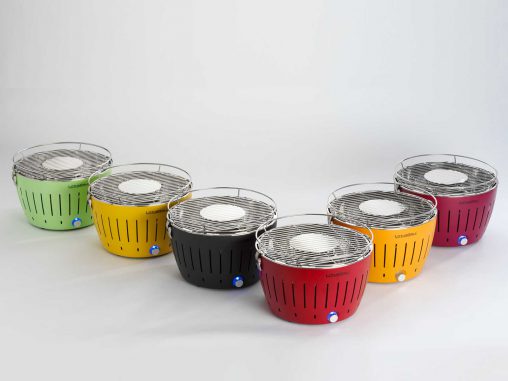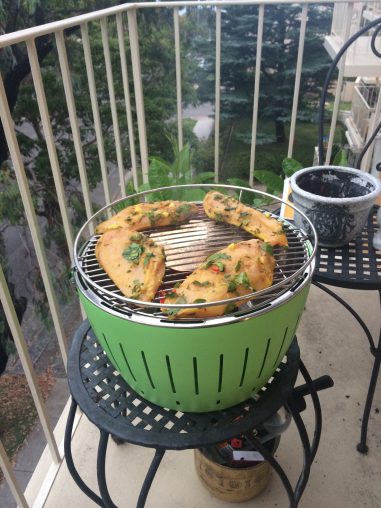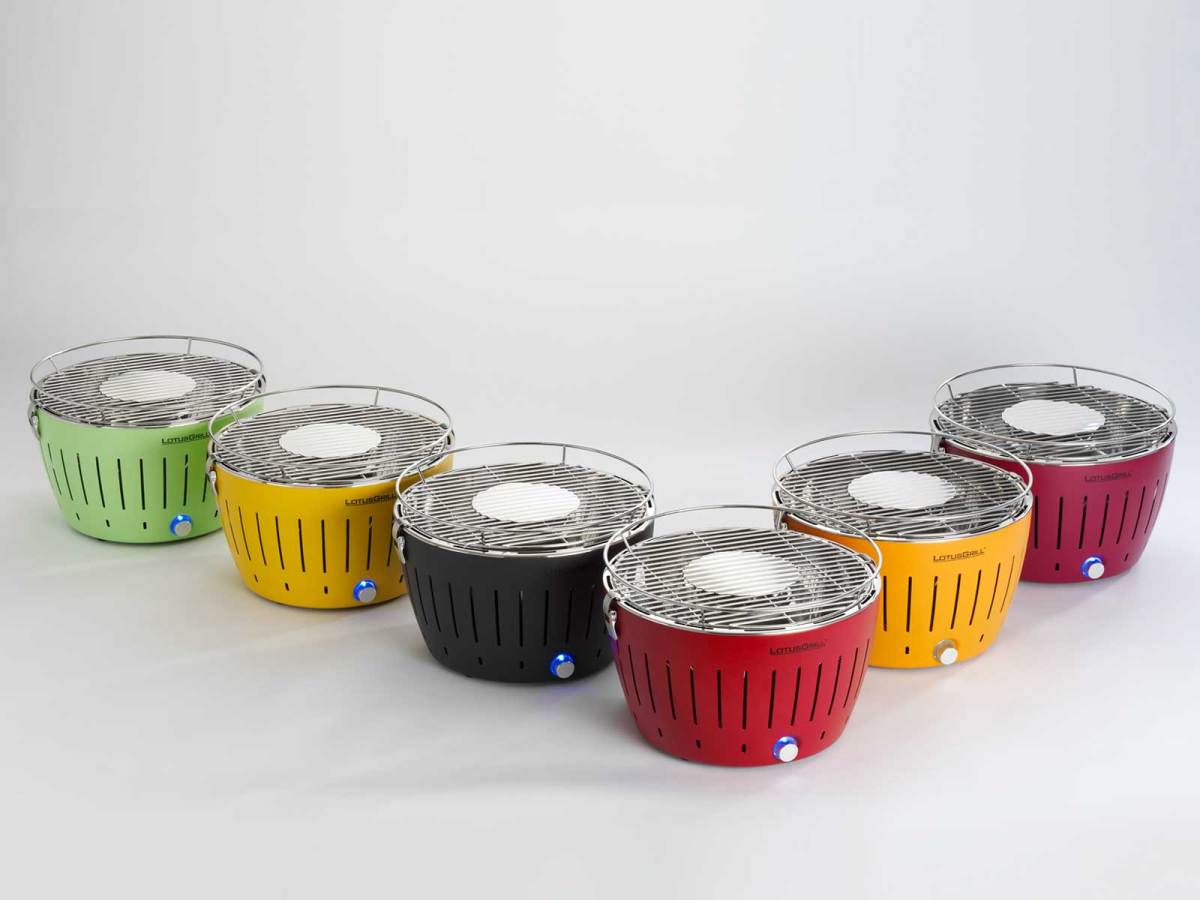This author is on Twitter: @Patrickavenell

Review
Have you ever used the hinge on a pair of tongs to break up charcoal to the size of a 50 cent piece, hitting the stubbornly resilient black chunks with such force that you cut hands in the process? Me neither, but I have watched my best friend do this and it was equally painful and amusing.
Over summer, I had the opportunity to review the LotusGrill by Zimba, a hemispherical barbecue that promises smokeless grilling in quicktime for delicious results. This deceptively small and light outdoor appliance is intended to be ultra-portable — the product photography has it grilling chicken on a yacht — and was somewhat ironically named Best in Category for Domestic Appliances at the 2012 Australian International Design Awards. While it can be used in a household setting, I thought it would be much more fun to take it out and about.

So on a recent weekend, my friend Cameron and I set out to put the LotusGrill through its paces. The local team sent me a Kermit Green model — it’s also available in maroon, black, orange, brown and purple — and the plan was to match the barbecue’s appearance to the green grass of a Harbourside park.
The first thing you realise about the LotusGrill is that it is not plug and play. While it does come with two batteries to power the internal fan, you need to purchase three things before you can even contemplate the sizzle of a choice cut of meat.
The first is hardwood charcoal — not heatbeads — which are easy enough to purchase from a Bunnings or Masters store (I opted for the Redhead brand natural wood charcoal, which costs $11.49 for 4 kilograms) though not natively at the 50 cent piece size recommended. That’s what led to Cameron self-harming in the name of charcoal downsizing.
While you’re at Bunnings, you need to purchase ethanol gel. Now colour me ignorant to the ways of barbecuing, but in all my years of sports carnivals, college open days and hungover fry ups, I’ve never come across such a fuel. The gel comes in a clear container, about the same shape and size as a Powerade bottle, and is marketed by Diggers. Bunnings retails it for $5.95 so it is not too expensive.
The final fundamental accessory is matches. Simple enough, and obviously one should invest in the long-twigged variety, but indicative of a flaw we would soon encounter in the barbecue: it is nigh on impossible to get started in windy conditions. Unlike barbecues with gas burners and electrical ignitions, protected from the elements by hoods and splashbacks, the LotusGrill requires you to light the ethanol gel, with the heat then fed and circulated by the fan-powered air movement, to make the charcoal glow hot in preparation for grilling. You could say the LotusGrill needs to be ‘incendivised’.
Having gone to all the trouble — literally drawing blood — to get small enough charcoal bits that fit into its cavity, which is slightly thicker than a 375-millilitre can, we found it impossible to light in the admittedly strongish wind blowing off Sydney Harbour that day.
Winners never quit and quitters never win, but people who neither win nor quit are just idiots. We chose to risk idiocy by relocating to the shared backyard in my apartment block. With a classically Australian red brick protective buffer from the Harbour zephyr now insulating the LotusGrill, we were able to ignite the ethanol gel and then let the fan do its work to fire up the charcoal to a vermilion glow.
On the 35-centimetre grill we placed gourmet lamb sausages, South African boerewors, premium filet mignon, spatchcocked pheasant and several steaks. While there was some spitting at first and smokiness, which does contradict the ‘smokeless grill’ pledge, it does say in the literature that when the LotusGrill “is first lit you will get a little bit of smoke; often this is inferior pieces or dust in the charcoal. This will quickly settle down to virtually no smoke, hence the smokeless grill”.

One of the reasons for the smokiness is that we made the mistake of placing meat on the griddle-esque circular plate at the centre of the grill. This is ill-advised as it will cause excess smoke, as there is no place for the fat to drain away.
Cooking is slow at first while one waits for the grill to get going but once at full temperature, the sausages and steaks sizzle and the spatchcock was juicy, tender and, importantly, cooked through in quick time. The food was delicious.
Turn off the LotusGrill’s fan and the air will stop circulating and, eventually, after a very long time, the charcoal will burn out. You can hasten this process by pouring water over the charcoal canister; you simply must do this outside and away from any open windows lest you want to set off several smoke alarms in your apartment building!
Even while on, the LotusGrill’s exterior doesn’t become too hot to touch, so upon extinguishing the charcoals you can immediately carry it to a sink for surprisingly easy cleaning. A few wipes with a damp cloth will remove the grease and grime though it will take a more sincere effort to get the charcoal bay sparkling again. The manufacturer says that, “Both the grill plate and inner bowl can be placed in the dishwasher or be hand washed. Avoid using general scouring harsh abrasive scourers as they will scratch the stainless steel bowl, a kitchen dish brush with detergent should be sufficient”.
All-in-all, the LotusGrill is an excellent if at times finicky barbecue. It’s not hard to imagine users becoming frustrated with the limited size of the grilling surface, the slowish heat-up time and the need to smash charcoal bits with the blunt end of pair of tongs. While the presskit shows happy German families using the LotusGrill in a variety of outdoor settings, I found it impossible to start in windy conditions and the suspicion is that it is best suited to a fixed home on an apartment balcony.
After launching at RRP $299, it’s now being sold for $249 on the LotusGrill website, while the larger 42-centimetre XL version is now $399 (after launching for RRP $499).
The local distributors have in the past expressed a desire to get the LotusGrill into more retailers but the feedback has been a lack of confidence in this product to be saleable at the original RRPs. Cameron Romeril, who heads up the sales and marketing for the LotusGrill in Australia (and is not the same Cameron as the one in the story) said retailers who have taken on the barbecue and supported it have been rewarded.
“The product range looks stunning set up in a retail space, given its vibrant colour palette and aesthetically appealing design,” he said. “We have found retailers who do this have benefited the most from this breakthrough product.
“There is also a lid and pizza stone sold separately that make great add-on sales. Around a third of consumers are taking up these add-ons, as being able to cook in wind, roast lamb or make a pizza are incredibly appealing options to have. We really have only just ended our launch phase and now is the time a focused national drive.”
Romeril said consumer feedback had been very positive and there had only been “a handful of returns after thousands of sales over two years”.

